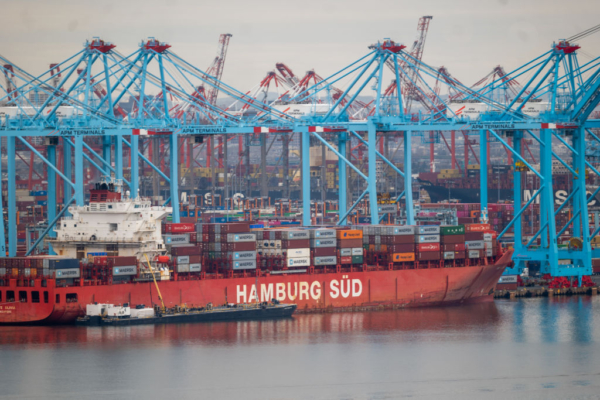From October 1, 2024, if labor negotiations continue to be deadlocked, around 45,000 union workers may go on strike at ports along the U.S. East Coast and the Gulf of Mexico. This could disrupt operations at 36 ports, cutting off vital trade routes before the U.S. presidential election and causing up to $5 billion in losses to the U.S. economy every day.
The six-year contract between the International Longshoremen’s Association (ILA) union and the United States Maritime Alliance (USMX) employer group expired at midnight on Monday, September 30. Negotiations on salary issues between the two parties have reached an impasse with ILA announcing a strike starting from Tuesday, September 1.
Part-time dockworkers earn annual salaries of $25,000, while skilled crane operators and supervisors can earn up to $300,000 annually.
According to Reuters, analysis by JPMorgan predicts that the strike could cost the U.S. economy $5 billion per day.
The strike is expected to impact around half of the U.S. maritime import volume handled by the 36 ports, affecting the supply of a range of goods from bananas and clothing to automobiles. Additionally, the strike could lead to weeks-long backlogs at the ports.
Experts suggest the strike may also drive up shipping costs, which could be passed on to U.S. voters already frustrated by housing and food inflation.
The White House has indicated it will not intervene as it did during last year’s negotiations on the West Coast.
A widespread and prolonged strike could result in shortages and increased costs across industries, potentially raising consumer prices.
Data from S&P Global Market Intelligence shows that within the 12 months ending June 30, 2024, the ports covered under the ILA-USMX contract handled $37.8 billion worth of automobile imports, with the Port of Baltimore in Maryland topping the national list for automobile transport.
In addition to automobiles, the ports also transport significant volumes of machinery, structural steel, and precision instruments, leading in the U.S. with values of $97.4 billion, $16.2 billion, and $15.7 billion respectively.
The American Farm Bureau Federation estimates that approximately 14% of the total U.S. waterborne agricultural exports by quantity will be affected by the strike. The potential value of these exports within a week is estimated to be $318 million. Furthermore, 53% of U.S. waterborne agricultural imports would also be impacted, with a potential economic impact exceeding $1.1 billion per week.
Jason Miller, interim director of Supply Chain Management at Michigan State University, highlights that three-fourths of bananas imported from countries like Guatemala and Ecuador are unloaded at ports along the East Coast and the Gulf of Mexico.
Additionally, goods such as coffee, cocoa, and cotton for export are also expected to be affected by the strike.
Mike Steenhoek, Executive Director of the Soy Transportation Coalition, points out that the strike will impact container exports of soybeans, soybean meal, and other products, significantly affecting refrigerated or frozen meat and egg production.
The refrigerated containers are vital for the yearly $18 billion beef and pork export industry, and the $5.8 billion poultry and egg industry as they cannot remain idle for long periods.
Joe Schuele, spokesperson for the U.S. Meat Export Federation, notes that approximately 45% of the total U.S. pork exports and 30% of beef exports for the first seven months of the year were transported through ports along the East Coast and the Gulf of Mexico.
Data from Everstream Analytics demonstrates that over 91% of pharmaceutical container imports and 69% of container exports in the U.S. are handled at ports affected by the strike.
Over a third of containers carrying life-saving drugs leave the U.S. through the Port of Norfolk in Virginia, while nearly a third of pharmaceutical imports arrive at the Port of Charleston in South Carolina.
Around half of all containers are filled with goods for retailers. Many U.S. retailers have already begun stockpiling goods for the upcoming holiday season.
S&P Global Market Intelligence data indicates that the affected ports carry over half of the country’s knit and non-knit apparel, totaling $32.8 billion, as well as $23.4 billion worth of furniture.
While Houston and New Orleans are major ports for oil and natural gas transport along the Gulf Coast, these commodities are less likely to be affected by the strike related to labor-intensive container cargo. Coal exports from the Port of Norfolk, Virginia, are also expected to continue unaffected.
The ILA union has pledged to handle military cargo and services for passenger cruise ships during the strike.
Broadly, the strike will increase shipping costs and lead to prolonged delays.
John McCown, Senior Researcher at the Center for Maritime Strategy, notes that negotiations involve the top five ports in the country—New York and New Jersey, Savannah in Georgia, Houston, Norfolk, and Charleston—which handled over 1.5 million 20-foot equivalent units (TEUs) worth $83.7 billion in August. About two-thirds of these goods are imports while the rest are exports.
Logistics experts warn that trade disruptions caused by the work stoppage will begin immediately, triggering supply chain issues.
Analysts at the Copenhagen-based shipping consultancy firm Sea-Intelligence estimate that it could take four to six days to clear backlogged cargo from just one day of strike action.
Maersk, one of the largest maritime suppliers and a member of the employer group, warns that a week-long shutdown could require up to six weeks for recovery, with “significantly more congestion and delays mounting by the day.”

